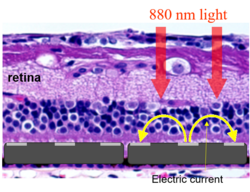Engineering:Photovoltaic retinal prosthesis
Photovoltaic retinal prosthesis is a technology for restoration of sight to patients blinded by degenerative retinal diseases, such as retinitis pigmentosa and age-related macular degeneration (AMD), when patients lose the 'image capturing' photoreceptors, but neurons in the 'image-processing' inner retinal layers are relatively well-preserved.[1] This subretinal prosthesis is designed to restore sight by electrically stimulating the surviving inner retinal neurons, primarily the bipolar cells. Photovoltaic retinal implants are completely wireless and powered by near-infrared illumination (880 nm) projected from the augmented-reality glasses. Lack of trans-scleral cable greatly simplifies the implantation procedure compared to other retinal implants.[2] Optical activation of the photovoltaic pixels allows scaling the implants to thousands of electrodes and retains natural coupling of the eye movements to visual perception. Studies in rats with retinal degeneration demonstrated that prosthetic vision with such subretinal implants preserves many features of natural vision, including flicker fusion at high frequencies (>20 Hz), adaptation to static images, antagonistic center-surround organization and non-linear summation of subunits in receptive fields, providing high spatial resolution.[3]
Clinical trial with the first-generation of such implants (PRIMA, Pixium Vision) having 100μm pixels demonstrated that AMD patients perceive letters and other patterns with spatial resolution closely matching the pixel size.[4] Moreover, central prosthetic vision is perceived simultaneously with the remaining natural peripheral vision.
The next-generation implants with 20μm pixels provided grating acuity matching the natural limit of resolution in rats (28μm).[5] Currently, such high-resolution implants are being optimized for human retina by Palanker group at Stanford University.
References
- ↑ Wang, Lele (2012). "Photovoltaic retinal prosthesis: Implant fabrication and performance". Journal of Neural Engineering 9 (4): 046014. doi:10.1088/1741-2560/9/4/046014. PMID 22791690. Bibcode: 2012JNEng...9d6014W.
- ↑ Mathieson, Keith (2012). "Photovoltaic retinal prosthesis with high pixel density". Nature Photonics 6 (6): 391–397. doi:10.1038/nphoton.2012.104. PMID 23049619. Bibcode: 2012NaPho...6..391M.
- ↑ E. Ho (2018). "Spatio-temporal Characteristics of Retinal Response to Network-mediated Photovoltaic Stimulation". Journal of Neurophysiology 119 (2): 389–400. doi:10.1152/jn.00872.2016. PMID 29046428.
- ↑ D. Palanker (2022). "Simultaneous Perception of Prosthetic and Natural Vision in AMD Patients". Nature Communications 13 (1): 51321. doi:10.1038/s41467-022-28125-x. PMID 35082313. Bibcode: 2022NatCo..13..513P.
- ↑ B.Y Wang (2022). "Electronic Photoreceptors Enable Prosthetic Vision with Acuity Matching the Natural Resolution in Rats". Nature Communications 13 (1): 6627. doi:10.1038/s41467-022-34353-y. PMID 36333326.
External links
 |



